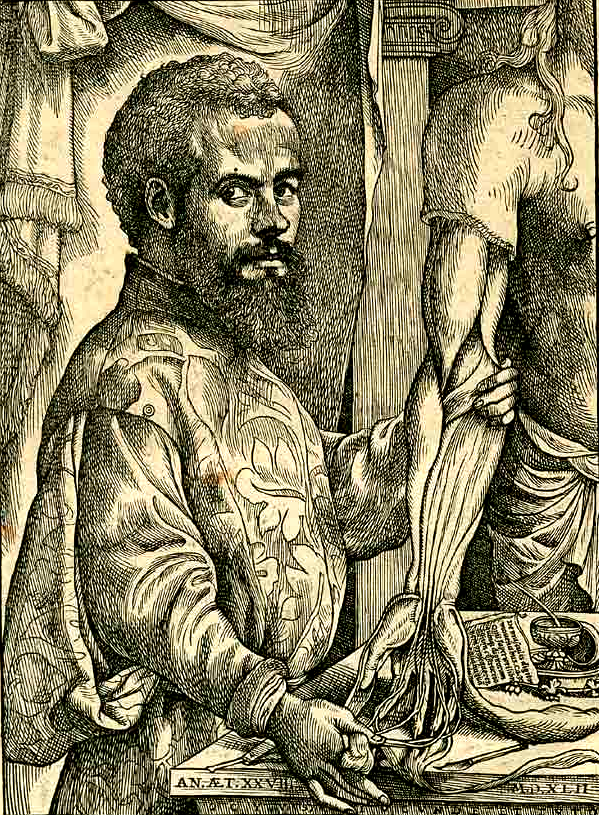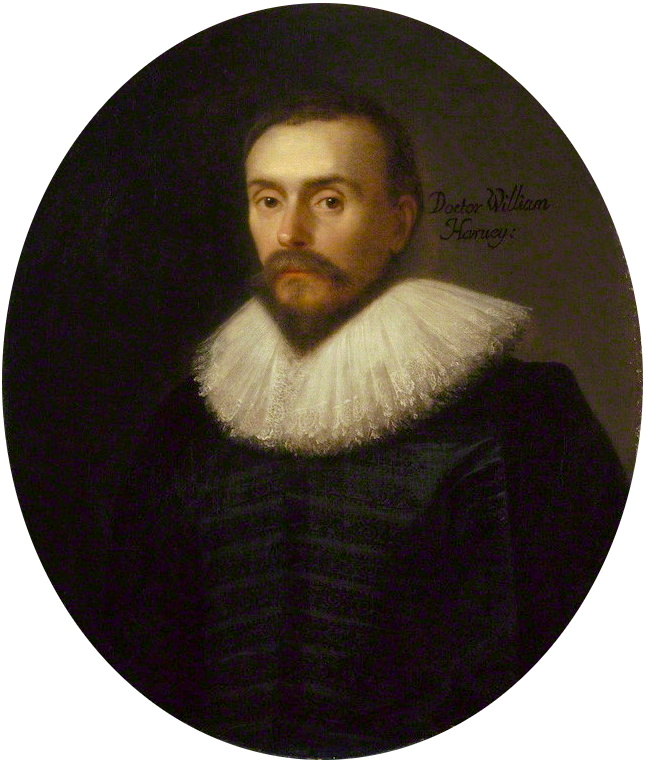Although the Scientific Revolution was associated with great accomplishments in astronomy, mathematics, and new scientific methods, we cannot ignore the great innovations in medicine. Medicine during the Middle Ages was greatly influenced by Galen who sought to study anatomy and physiology by using an animal as a cadaver; however this proved to be an insufficient model of the true anatomy of the human body. Furthermore, Galen’s hypothesis that the body had two blood systems and diseases could be cured by looking deeper into the four humors in the body proved to be grossly erroneous. When Paracelsus, Vesalius, and Harvey came onto the medical scene during the 16th and 17th century, medicine started to evolve into a more precise and exact science.
William Harvey
William Harvey’s book “On the Motion of the Heart and Blood” published in 1628, proved that there was, in fact, only one type of blood that flowed in the arteries and veins. Furthermore, with meticulous testing and experimentation, he also added that the heart was the starting point of the blood system. His work, although it made complete sense to him, was not widely accepted until 1660’s when he discovered that capillaries provided a path for the blood to travel from arteries to veins. William Harvey is credited as laying the foundation for modern physiology
Paracelsus
 Paracelsus’s methods were based on a new chemical philosophy, in contrast, the universities were still using traditional Galen’s principles and Paracelsus did not agree with this method of teaching. His methods were based on experimentation and a chemical philosophy based on the harmony of man (the microcosm) and Nature (macrocosm). Paracelsus believed that actions that occurred within the body were the result of the universe, on a smaller scale of course. This notion, although it deterred from Galen’s previous findings, was that chemical imbalances in the body were found in certain organs and could be treated with specific remedies. These, of course, proved that imbalances of the four humors were not the underlying factors in diagnosing certain illnesses. This prompted Paracelsus to start dedicating his time to producing chemicals and minerals that could be used in certain doses for specific ailments. He did meet opposition, as many believed he was infecting patients with the same disease they had in order to cure it, and this may in fact have been right. In all actuality, his findings have made him the father of modern medicine, and to some of the Scientific Revolution, the first person to study in depth homeopathic and holistic medicine.
Paracelsus’s methods were based on a new chemical philosophy, in contrast, the universities were still using traditional Galen’s principles and Paracelsus did not agree with this method of teaching. His methods were based on experimentation and a chemical philosophy based on the harmony of man (the microcosm) and Nature (macrocosm). Paracelsus believed that actions that occurred within the body were the result of the universe, on a smaller scale of course. This notion, although it deterred from Galen’s previous findings, was that chemical imbalances in the body were found in certain organs and could be treated with specific remedies. These, of course, proved that imbalances of the four humors were not the underlying factors in diagnosing certain illnesses. This prompted Paracelsus to start dedicating his time to producing chemicals and minerals that could be used in certain doses for specific ailments. He did meet opposition, as many believed he was infecting patients with the same disease they had in order to cure it, and this may in fact have been right. In all actuality, his findings have made him the father of modern medicine, and to some of the Scientific Revolution, the first person to study in depth homeopathic and holistic medicine. Vesalius
 Andreas Vesalius, although a great supporter of Galen’s practices, deviated from the traditional dissection of animals to dissecting on a human cadaver to prove what he was studying. Vesalius’s anatomical treatise examined the organs of the body, their location, and the entire system. Vesalius, along with with several artists during the Renaissance, created a masterpiece called “On the Fabric of the Human Body” in 1543, which clearly illustrated anatomical models more advanced that anyone had ever seen. Vesalius took the findings of Galen, one of those being that blood vessels originated from the liver, and corrected it to meet with his findings. Vesalius still agreed that there were two types of blood in the veins and arteries in the body, however this perception was proved to be false by William Harvey during the 17th century.
Andreas Vesalius, although a great supporter of Galen’s practices, deviated from the traditional dissection of animals to dissecting on a human cadaver to prove what he was studying. Vesalius’s anatomical treatise examined the organs of the body, their location, and the entire system. Vesalius, along with with several artists during the Renaissance, created a masterpiece called “On the Fabric of the Human Body” in 1543, which clearly illustrated anatomical models more advanced that anyone had ever seen. Vesalius took the findings of Galen, one of those being that blood vessels originated from the liver, and corrected it to meet with his findings. Vesalius still agreed that there were two types of blood in the veins and arteries in the body, however this perception was proved to be false by William Harvey during the 17th century.The Late Middle Ages saw a great evolution of anatomical medicine and modern physiology. The teachings of Galen were proved to be faulty as new scientists started to branch out and try new procedures. Paracelsus, Vesalius, and Harvey were able to deter from Galen’s previous findings, although meeting resistance along the way, and pave the way for modern medicine.








5 Comments:
There was a lot of trial and error within the procees. No doubt these were the trail blazers for modern medicine. Well presented and well written piece of history.
A great post..I really enjoy this history. thanks for doing it.I would like to see some of the drawings. I think i will try to find them :)
I hope you have a great week .thanks so much for all of your comments on Ma Promenade.
Carl
Nice. This baled me with my AP Euro homework :) so thanks. Scary to think that this stuff wasn't known back then. I mean, our doctors know that we have one blood system, that he white blood cells fight off infection, and that blood can recreate itself. Basically the scientists back then guessed it was blue from the veins. It kinda scares me to think that this was new knowledge and now we think that stem cells are new knowledge. What about 500 years from now? What then?
@Puddingprince101
I'm so glad the info was of use to you. Yes, the approaches they used to medicine at this time was less than efficient. Did you know that many doctors actually drank urine to see if it tasted funny? They would then prescribe a cure using the taste as a sort of symptom. So odd!
Paracelsus was a great doctor od old times, I learnt that he improved his skills, travving all over Europe http://www.fampeople.com/cat-paracelsus
Post a Comment
We appreciate comments, but we delete SPAM.